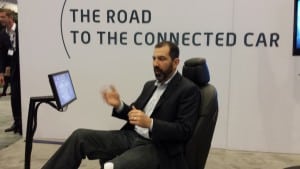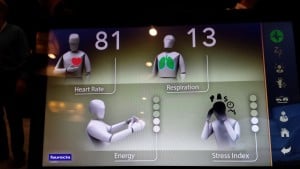 The Connected Car Expo at the LA Auto Show is in its third year and AUTO Connected Car News has seen it grow monumentally. In fact, the show has such a large following it won the Tech CARS Award for best connected car trade show or symposium. This year, the show outgrew the Los Angeles Convention Center and moved the J.W. Mariott Hotel adjacent to LA Live.
The Connected Car Expo at the LA Auto Show is in its third year and AUTO Connected Car News has seen it grow monumentally. In fact, the show has such a large following it won the Tech CARS Award for best connected car trade show or symposium. This year, the show outgrew the Los Angeles Convention Center and moved the J.W. Mariott Hotel adjacent to LA Live.
CNET’s Brian Cooley hosted the presentations with sound bytes to tantalize the media world and give a glimpse of the present state of connected cars and what we may see in the future which could add up to three trillion or so miles.
Semi-Autonomous Mayor, RoboTaxis and Lyfts for Kids
 There are new ways people in Los Angeles are getting around town and in the future there won’t be RoboCops but could be RoboTaxis and self-driving cars.
There are new ways people in Los Angeles are getting around town and in the future there won’t be RoboCops but could be RoboTaxis and self-driving cars.
Mayor Garcetti drove the streets of downtown in a semi-autonomous Volvo. Lyft’s CEO Jeff Zimmer touted new approaches to how cars will be used in the future. Eric Spiegelman, president of the LA Taxi Commission, foresees a future of RoboTaxis that serve South Los Angeles as well as Hollywood. There are 30,000 ride-sharing drivers like Uber and Lyft already in Los Angeles—which is why it takes only five minutes to get an Uber or Lyft ride in Hollywood but much longer in South Los Angeles. When the drivers are gone it will only cost 25 a mile for a RoboTaxi which will make most rides cheaper than taking the bus.
Parents finally have an option for getting their kids to soccer practice, ballet classes, or getting home from school HopSkipDrive.
“Background checks are very important for drivers,” said Joanna McFarland, co-founder, HopSkipDrive who noted that HopSkipDrive’s drivers are fingerprinted, interviewed in person, have their driving records checked and also must have five years of child care experience. The drivers will sign in/out the child and stay with the child if needed.
We Can Drive for Trillions and Trillions and Trillions and Trillions of Miles
Don’t assume that all the ride-sharing will reduce the number of miles driven. KPMG presented a new report that estimates autonomous vehicles, connectivity, and mobility-on-demand will have a huge impact on consumers, especially younger and older people, vastly increasing the vehicle miles traveled (VMT) in the U.S. by approximately one trillion additional miles per year by 2050. Boomers are not going to stop being active. Young people aged 10-15 want to get around too, mobility-on-demand will be especially attractive for parents in the future. Then when people select new self-driving options in the future—then demand could double. When occupancy rates fall below one person per car—for example, many self-driving cars without passengers—then the increase could grow to three to four trillion additional miles by 2050.
Confused Car Buyers
As the technology features grow for cars, car buyers are becoming more confused noted panelists discussing “What Research Reveals About Buyers’ Deepest Desires.” Strategy Analytics’ Roger Lanctot suggested that the industry needs to define the word “connected car” because people are confused. Although there have been a lot of advertising for technology connecting cars to smartphones, panelists agreed that safety is the most important feature for car buyers even though car buyers don’t want to pay too much for it.
3-D Printed Cars that Can Be Re-Printed
The ways cars will be made is changing too. Local Motors crowd-sources car designs, prints them with a 3D printer using plastic and carbon fiber and within a few months spits out a newly designed car such as the LM3D Swim dazzled Justin Fishkin, chief strategy officer. If the car gets into an accident depending on the accident, Local Motors may print a new fender or melt it down and re-print it.
The California Learning Curve
Automakers are learning from Silicon Valley and vice a versa. Nick Sugimoto, senior program director, at Honda Silicon Valley Lab said that they were testing integration of Siri into cars before Apple bought the company. Then afterwards, Honda asked Apple to redesign Siri for cars which became “Siri-Eyes-Free.” Honda then re-flashed some model cars’ Bluetooth so that Siri-Eyes-Free worked correctly.
Updates, Apps, Cyber Security & Stressless
 Car companies will be updating software like smartphones are updated with Over-the-Air updates, in the near future, an entire panel was devoted to subject. More apps are being developed. Nokia is helping apps grow and showed its Growth Partner apps— Citymaps, Nauto, Parkwhiz, Rivet Radio, Zubie, Prazo, Openbay, Traffic Technologies Services, Autosport Labs, Vision Fleet and Zirx.
Car companies will be updating software like smartphones are updated with Over-the-Air updates, in the near future, an entire panel was devoted to subject. More apps are being developed. Nokia is helping apps grow and showed its Growth Partner apps— Citymaps, Nauto, Parkwhiz, Rivet Radio, Zubie, Prazo, Openbay, Traffic Technologies Services, Autosport Labs, Vision Fleet and Zirx.
Cyber security for cars may be a problem but can be developed  reported Andre Weimerskirch, Associate Research Scientist, UMTRI but it may squelch some features such as platooning or caravanning (where one car leads several cars using cellular wireless data for now. Drivers shouldn’t expect much from the Federal Government said attorney David Strickland, Partner, Venable, former Administrator of the National Highway Traffic Safety Administration (NHTSA), until after hacks, such as the case with the Jeep Cherokee hack heard round the world.
reported Andre Weimerskirch, Associate Research Scientist, UMTRI but it may squelch some features such as platooning or caravanning (where one car leads several cars using cellular wireless data for now. Drivers shouldn’t expect much from the Federal Government said attorney David Strickland, Partner, Venable, former Administrator of the National Highway Traffic Safety Administration (NHTSA), until after hacks, such as the case with the Jeep Cherokee hack heard round the world.
Drivers have nothing to worry about because their stress of driving in Los Angeles can be reduced. The car is becoming the new “Fitbit,” a biomedical sensing chair from Faurecia checks the pulse in your back and buttocks, when you’re stressed it massages your body.